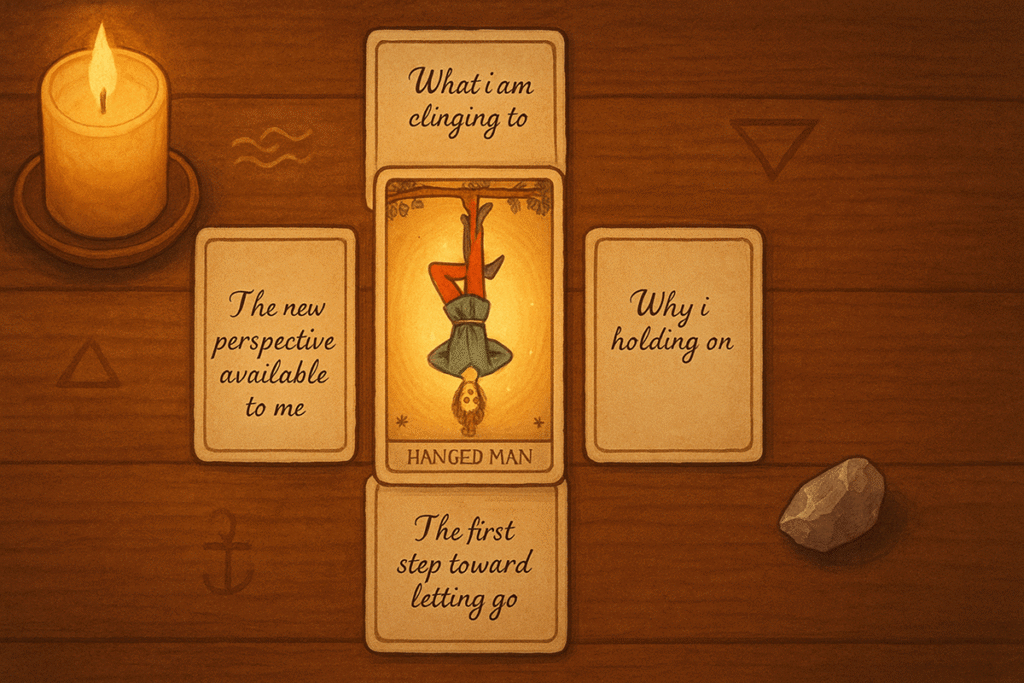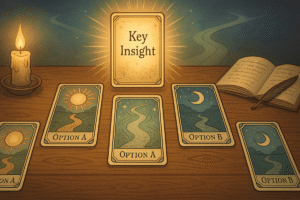Table of Contents
There’s something uniquely uncomfortable about The Hanged Man card that I’ve always found fascinating. Perhaps it’s the way the figure dangles there, completely suspended, yet somehow serene. When this card appears in readings, I notice people often shift in their seats. The imagery challenges our instinct to always be moving, always be doing, always be in control.
Yet The Hanged Man offers profound wisdom about surrender and the art of letting go. Today, I want to share a tarot spread inspired by this card’s gentle teachings about release and renewal. This isn’t about forcing yourself to abandon everything you hold dear, but rather about exploring what might be ready for a natural, conscious release in your life.
Understanding The Hanged Man’s Message
The Hanged Man teaches us that sometimes the most powerful action is inaction. Sometimes the greatest strength lies in surrender. I think many of us struggle with this concept because we’re conditioned to believe that letting go equals giving up. But there’s a profound difference between these two states.
When we cling too tightly to people, situations, or even ideas about how our lives should unfold, we can create unnecessary suffering for ourselves. The Hanged Man suggests that by loosening our grip, we might discover new perspectives we couldn’t see while we were struggling to maintain control.
This card doesn’t ask us to become passive or resigned. Instead, it invites us to explore what conscious surrender might look like. What would it feel like to trust the process of life a little more? What new viewpoints might emerge if we stopped pushing so hard against certain currents?
The Letting Go Tarot Spread Layout
This four card spread draws its wisdom directly from The Hanged Man’s core themes. Each position offers a different lens through which to examine your relationship with release and renewal. I’ve found that approaching this spread with curiosity rather than expectation tends to yield the most meaningful insights.
The cards are laid out in a simple vertical line, mirroring The Hanged Man’s suspended position. This layout feels appropriate somehow, creating a visual reminder of the card’s central message about finding stillness and clarity through surrender.
Position 1 sits at the top, representing what you might be clinging to. Position 2 follows below, exploring the why behind your attachment. Position 3 offers the new perspective that might be available to you, while Position 4 at the bottom suggests a gentle first step toward release.
Position One: What I Am Clinging To
The first card in this spread asks you to examine what you might be holding onto too tightly in your current life situation. This isn’t necessarily something “bad” that needs to be eliminated. Often, we cling to beautiful things, cherished dreams, or familiar patterns that once served us well.
I remember doing this reading for myself during a period when I was desperately trying to force a creative project to succeed. The card that appeared in this position helped me recognize that my attachment wasn’t to the project itself, but to a very specific vision of how it should unfold. Sometimes what we’re clinging to is our own agenda rather than the thing itself.
When you draw this card, consider asking yourself: What am I afraid to lose? What do I find myself repeatedly worrying about or trying to control? The answer might surprise you. Perhaps you’re holding onto past versions of yourself, expectations about how others should behave, or assumptions about what your future must look like.
This position invites honest self reflection without judgment. There’s nothing inherently wrong with caring deeply about people or outcomes. The question is simply whether your current relationship with this attachment is serving your highest good.
Position Two: Why I Am Holding On
The second position digs deeper into the emotional and psychological roots of your attachment. Understanding why we cling to certain things can be incredibly illuminating. Often, our grip tightens around what feels most essential to our sense of safety, identity, or worth.
Sometimes we hold on because letting go feels like admitting failure. Other times, our attachment stems from a fear that if we release this particular thing, we’ll never find anything like it again. I’ve noticed that many of my own tightest grips have been rooted in scarcity thinking, the belief that there isn’t enough love, opportunity, or joy to go around.
The card in this position might reveal patterns you weren’t fully conscious of. Perhaps you’re holding on to control because uncertainty feels overwhelming. Maybe you’re clinging to a relationship dynamic because changing it would require you to examine uncomfortable truths about yourself.
This isn’t about pathologizing your attachments or making them wrong. It’s about developing compassion for the very human needs and fears that drive your behavior. When you understand why you’re holding on, you can begin to address those underlying needs in healthier ways.
Position Three: The New Perspective Available to Me
Here’s where The Hanged Man’s wisdom really begins to shine through. This position asks what different viewpoint might be available to you if you could loosen your grip, even slightly. Sometimes we become so focused on one particular outcome that we miss entirely different possibilities that might be even more fulfilling.
The Hanged Man sees the world upside down, and this shift in perspective often reveals truths that were invisible from the upright position. The card you draw here might suggest a completely different way of approaching your situation, or it might offer a gentle reframe that transforms your entire experience.
I find this position particularly fascinating because it often reveals opportunities that were hiding in plain sight. When we’re tightly focused on making one specific thing happen, we can develop tunnel vision that blocks out alternative paths. The new perspective might be simpler than you expect, or it might be more creative and unconventional than you initially considered.
Sometimes the new perspective is about timing. Perhaps what you’re trying to force right now would unfold much more naturally at a different pace or season in your life. Other times, it’s about approach. Maybe there’s a gentler way to pursue what you want, or maybe what you truly desire is actually something slightly different than what you thought.
Position Four: The First Step Toward Letting Go
The final position offers practical guidance for beginning the process of release. This isn’t about dramatic gestures or sudden abandonment. True letting go usually happens gradually, through small acts of trust and surrender practiced consistently over time.
The card here might suggest a specific action you can take, or it might point toward an internal shift in attitude or awareness. Sometimes the first step is simply noticing when you’re tightening your grip and consciously choosing to soften your hold. Other times, it might involve having a difficult conversation or making a small change in your daily routine.
I’ve learned that letting go is often less about removing things from your life and more about changing your relationship to them. You might not need to end that friendship, but perhaps you could stop trying to control how often your friend calls. You might not need to abandon your dream, but maybe you could release your rigid timeline for achieving it.
This position recognizes that letting go is a practice, not a one time event. The first step is just that, a beginning. Be gentle with yourself as you explore what conscious release might look like in your unique situation.
Working With Your Reading
Once you’ve drawn all four cards, take some time to notice the overall energy and themes that emerge. Do the cards seem to be telling a cohesive story? Are there any surprising connections or contradictions that catch your attention?
I like to journal with these readings, writing down my initial impressions and then coming back to them over the following weeks to see what insights develop over time. Sometimes the meaning of a particular card doesn’t become clear until I’m actually living through the process of letting go.
Remember that this reading is meant to support your own inner wisdom, not replace it. The cards offer perspectives and possibilities, but you remain the expert on your own life. If something doesn’t resonate, trust that instinct. If a particular insight feels especially meaningful, pay attention to that response.
Embracing The Hanged Man’s Patience
Perhaps the most important lesson The Hanged Man offers is that some things simply cannot be rushed. There’s a season for holding on and a season for letting go, and trying to force either can create unnecessary struggle.
If your reading reveals that you’re not quite ready to release something, that’s perfectly valid information. Sometimes the first step toward letting go is simply acknowledging what you’re clinging to and why. Awareness itself can be transformative, even when it doesn’t immediately lead to action.
The Hanged Man reminds us that surrender is not defeat. It’s a conscious choice to trust something larger than our individual will. Whether you call that trust, the universe, or simply the natural wisdom of life’s unfolding, the invitation remains the same: to soften your grip and see what new possibilities emerge.
As you continue working with this spread, remember that letting go is ultimately an act of faith. Faith that you are resilient enough to handle uncertainty. Faith that releasing what no longer serves you creates space for what does. Faith that sometimes the most courageous thing you can do is stop fighting and start flowing.
The Hanged Man dangles there peacefully, teaching us that even in suspension, even in surrender, there can be profound grace and wisdom. May your own journey of letting go be filled with that same gentle strength.
Frequently Asked Questions
Should I do this spread when I’m feeling very emotional about what I need to let go?
Yes, this can actually be an ideal time to work with this spread. While some tarot spreads work best when you’re feeling calm and centered, letting go spreads often provide the most meaningful insights when your emotions are still raw and present. The cards can help you identify patterns and perspectives that are difficult to see clearly when you’re in the thick of strong feelings, offering a gentle mirror for what you’re experiencing.
How long should I wait between doing this spread again on the same issue?
Give yourself at least a week or two before revisiting the same question with this spread. Letting go is a gradual process, not something that happens overnight. If you pull cards too frequently on the same issue, you might confuse the natural unfolding of insight with impatience or trying to control the outcome. Allow time for the messages from your first reading to settle and for you to observe how your relationship with the situation shifts naturally.
What if the cards suggest I’m not ready to let go yet?
That’s completely valid and valuable information. Sometimes the first step toward letting go is simply acknowledging that you’re still holding on and understanding why. There’s no timeline you must follow, and forcing release before you’re genuinely ready can create more resistance. Use what the cards reveal about why you’re holding on to address those underlying needs with compassion rather than judgment.
Can I use this spread for letting go of a person or relationship?
You can, though it’s important to approach this thoughtfully. This spread works best when you’re exploring your own attachment patterns and what internal shifts might serve you, rather than seeking definitive answers about whether a relationship should end. Focus on what you can learn about yourself through the process rather than looking for the cards to make decisions about other people for you.







